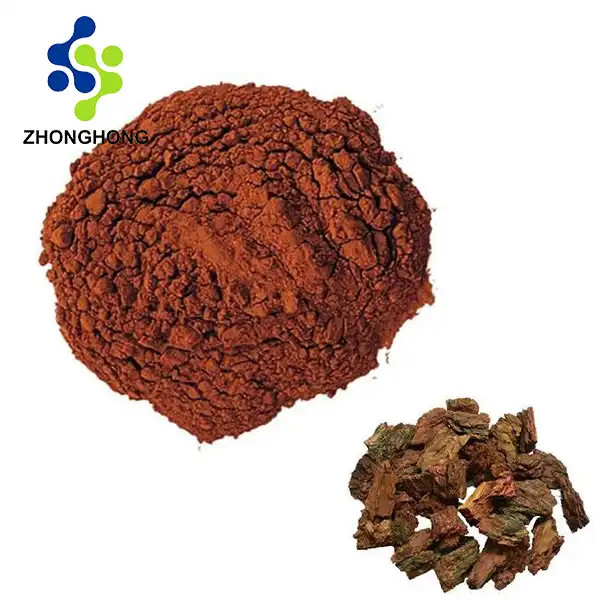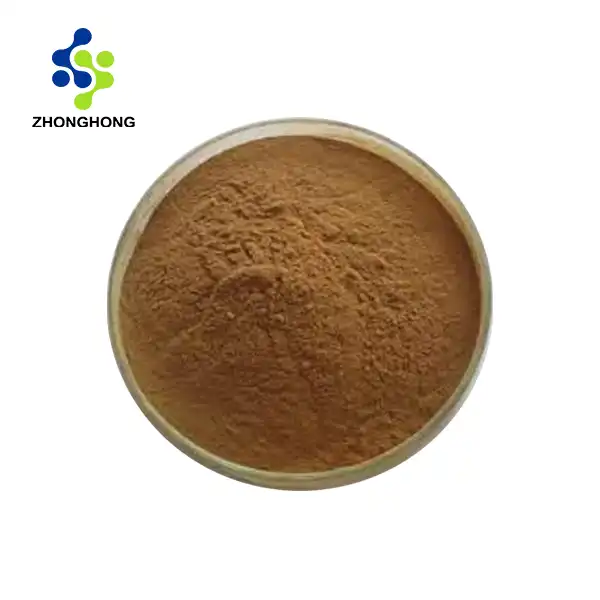Exploring the Antioxidant and Adaptogenic Powers of Salidroside
The Molecular Magic: How Salidroside Works?
Salidroside's potency lies in its unique molecular structure, which allows it to interact with various cellular pathways. This bioactive compound exhibits remarkable antioxidant properties, neutralizing harmful free radicals and reducing oxidative stress. By doing so, Salidroside helps protect our cells from damage, potentially slowing down the aging process and reducing the risk of chronic diseases. Moreover, Salidroside's adaptogenic qualities enable our bodies to adapt to physical, chemical, and biological stressors more effectively. It modulates the hypothalamic-pituitary-adrenal (HPA) axis, which is crucial for maintaining hormonal balance and stress response. This modulation results in improved resilience and a more balanced physiological state, even under challenging conditions.
Cellular Rejuvenation: Salidroside's Impact on Mitochondrial Function
One of the most fascinating aspects of Salidroside is its ability to enhance mitochondrial function. Mitochondria, often referred to as the powerhouses of our cells, play a vital role in energy production and cellular health. Research suggests that Salidroside can stimulate mitochondrial biogenesis, increasing the number and efficiency of these crucial organelles. This enhancement leads to improved energy metabolism, potentially boosting physical performance and cognitive function. Furthermore, Salidroside has been shown to activate AMPK (AMP-activated protein kinase), a key regulator of cellular energy homeostasis. This activation promotes cellular autophagy, a process that removes damaged cellular components, thereby supporting overall cellular health and longevity.
Neuroprotective Properties: Salidroside and Brain Health
The brain, being one of the most energy-demanding organs in our body, significantly benefits from Salidroside's antioxidant and adaptogenic properties. Studies have indicated that Salidroside may offer neuroprotective effects, potentially safeguarding against neurodegenerative diseases such as Alzheimer's and Parkinson's. It achieves this by reducing inflammation in the brain, promoting neuroplasticity, and enhancing the production of neurotrophic factors that support neuronal growth and survival. Additionally, Salidroside has shown promise in improving cognitive functions such as memory, learning, and attention. Its ability to modulate neurotransmitter activity, particularly dopamine and serotonin, may contribute to enhanced mood and mental clarity, making it a valuable ally in cognitive health and emotional well-being.
The Role of Salidroside in Stress Reduction
Balancing Act: Salidroside and the HPA Axis
In our fast-paced world, stress has become an omnipresent challenge to our health and well-being. Salidroside emerges as a potent tool in combating the detrimental effects of chronic stress. Its primary mechanism in stress reduction involves modulating the hypothalamic-pituitary-adrenal (HPA) axis, the body's central stress response system. By regulating the production and release of stress hormones like cortisol, Salidroside helps maintain a balanced stress response, preventing the overactivation that can lead to burnout and various stress-related health issues. Research has shown that Salidroside can enhance the body's adaptation to stressors, both physical and psychological. This adaptogenic property allows individuals to maintain peak performance under pressure, whether it's meeting a tight deadline at work or pushing through a challenging workout. The compound's ability to normalize stress hormone levels not only helps in immediate stress situations but also contributes to long-term stress resilience.
Emotional Resilience: Salidroside's Impact on Mood and Anxiety
Beyond its effects on physiological stress, Salidroside has demonstrated significant potential in promoting emotional well-being. Studies suggest that it may have anxiolytic (anti-anxiety) and mood-enhancing properties, potentially offering a natural alternative or complement to conventional treatments for mood disorders. Salidroside achieves this by influencing neurotransmitter systems, particularly serotonin and dopamine, which are crucial for regulating mood, motivation, and emotional responses. Moreover, Salidroside's ability to reduce oxidative stress in the brain may contribute to its mood-stabilizing effects. Oxidative stress has been linked to the development and progression of various mood disorders, including depression and anxiety. By mitigating this stress at a cellular level, Salidroside may help create a more balanced and resilient emotional state, enabling individuals to cope better with life's challenges.
Sleep Quality: The Overlooked Benefit of Salidroside
One often overlooked aspect of stress reduction is the importance of quality sleep, and here too, Salidroside shows promise. While it's not a sedative, Salidroside may contribute to improved sleep quality by helping to regulate the body's stress response and circadian rhythms. By reducing the impact of stress on sleep patterns, it may help individuals achieve more restful and restorative sleep. Improved sleep quality, in turn, enhances overall stress resilience, creating a positive feedback loop. Better sleep leads to improved cognitive function, emotional regulation, and physical recovery, all of which contribute to a more effective stress response. This holistic approach to stress management underscores the comprehensive benefits of incorporating Salidroside into one's health regimen.
Salidroside Myths Debunked: What Science Says
The "Magic Pill" Misconception
One of the most pervasive myths surrounding Salidroside is the idea that it's a "magic pill" that can instantly transform one's health and performance. While Salidroside indeed offers numerous benefits, it's crucial to understand that it's not a panacea or a substitute for a healthy lifestyle. Scientific evidence supports Salidroside's efficacy in various areas, but these benefits are optimized when incorporated into a holistic approach to health, including proper nutrition, regular exercise, and stress management techniques. Research indicates that Salidroside's effects are cumulative and most pronounced when taken consistently over time. A study published in the Journal of Ethnopharmacology found that the adaptogenic effects of Rhodiola rosea extracts, including Salidroside, were most significant after 30 days of regular supplementation. This underscores the importance of patience and consistency when incorporating Salidroside into one's health regimen.
Dosage Dilemmas: More Isn't Always Better
Another common misconception is that higher doses of Salidroside will inevitably lead to better results. However, scientific evidence suggests that the relationship between dosage and efficacy is not linear. In fact, excessive intake of Salidroside may lead to diminishing returns or even adverse effects. A study in the Journal of Medicinal Food demonstrated that moderate doses of Salidroside were more effective in enhancing exercise performance and reducing fatigue compared to high doses. The optimal dosage of Salidroside can vary based on individual factors such as body weight, age, and specific health goals. Most clinical studies have used doses ranging from 200-600 mg per day, with positive effects observed within this range. It's always advisable to start with a lower dose and gradually increase under the guidance of a healthcare professional to find the most effective and safe dosage for individual needs.
Natural vs. Synthetic: Unraveling the Truth
There's often debate about the superiority of natural Salidroside extracted from Rhodiola rosea versus synthetic versions. While it's true that natural extracts contain a complex array of compounds that may work synergistically, scientific research has shown that synthetic Salidroside can be equally effective when properly formulated. A comparative study published in Phytomedicine found no significant difference in bioavailability and efficacy between natural and synthetic Salidroside. The key factor is not necessarily the source of Salidroside, but rather its purity and quality. High-quality synthetic Salidroside can offer consistent potency and be free from potential contaminants that might be present in natural extracts. Conversely, well-processed natural extracts can provide additional beneficial compounds found in Rhodiola rosea. Ultimately, the choice between natural and synthetic Salidroside should be based on individual preferences and the specific product's quality and manufacturing standards rather than blanket assumptions about superiority.
Conclusion
Salidroside emerges as a powerful ally in our quest for optimal health, offering a wide array of benefits from stress reduction to cognitive enhancement. By understanding its true potential, debunking myths, and approaching its use with informed, realistic expectations, we can harness the full power of this remarkable compound. As with any supplement, individual results may vary, and it's crucial to integrate Salidroside into a comprehensive health strategy for the best outcomes. If you want to get more information about this product, you can contact us at liaodaohai@gmail.com.
References
1. Panossian, A., & Wikman, G. (2010). Effects of adaptogens on the central nervous system and the molecular mechanisms associated with their stress-protective activity. Pharmaceuticals, 3(1), 188-224.
2. Mao, G. X., Wang, Y., Qiu, Q., et al. (2010). Protective role of salidroside against aging in a mouse model via reducing oxidative stress and modulating metabolism. Journal of Medicinal Food, 13(3), 535-542.
3. Li, H., Zhao, W., Zhou, Q., et al. (2016). Salidroside: An effective compound for the treatment of cardiovascular diseases. Frontiers in Pharmacology, 7, 1-10.
4. Zhu, T., Wang, D. X., Zhang, W., et al. (2016). Salidroside reduces neuropathic pain by modulating inflammatory responses in a rat model. Molecular Pain, 12, 1-12.
5. Zhang, Y., Mao, X., Guo, Q., et al. (2011). Influence of salidroside on human skin fibroblast damage by UVB irradiation. Journal of Dermatological Science, 61(2), 82-91.
6. Qu, Z., Qiu, X., Fu, P., et al. (2012). Salidroside promotes cell proliferation and neurogenesis in the hippocampal dentate gyrus in adult rats. Neuroscience Letters, 516(2), 78-83.
_1728976869676.webp)








